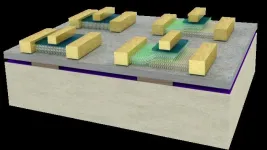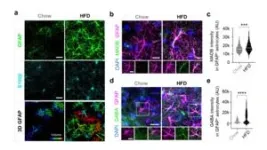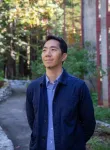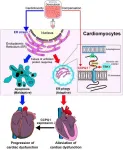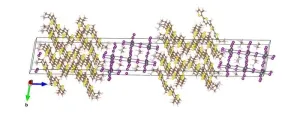Analog and digital: The best of both worlds in one energy-efficient system
The fusion of 2D semiconductors and ferroelectric materials could lead to joint digital and analog information processing, with significant improvement in energy consumption, electronic device performance, and lead to novel functionalities.
2023-08-31
(Press-News.org)
We live in an analog world of continuous information flow that is both processed and stored by our brains at the same time, but our devices process information digitally in the form of discrete binary code, breaking the information into little bits (or bites). Researchers at EPFL have revealed a pioneering technology that combines the potential of continuous analog processing with the precision of digital devices. By seamlessly integratingultra-thin, two-dimensional semiconductors with ferroelectric materials, the research, published in Nature Electronics, unveils a novel way to improve energy efficiency and add new functionalities in computing. The new configuration merges traditional digital logic with brain-like analog operations.
Faster and more efficient electronics
The innovation from the Nanoelectronics Device Laboratory (Nanolab), in collaboration with Microsystems Laboratory, revolves around a unique combination of materials leading to brain-inspired functions and advanced electronic switches, including the standout negative capacitance Tunnel Field-Effect Transistor (TFET). In the world of electronics, a transistor or "switch" can be likened to a light switch, determining whether current flows (on) or doesn't (off). These are the famous 1s and 0s of binary computer language, and this simple action of turning on and off is integral to nearly every function of our electronic devices, from processing information to storing memory. The TFET is a special type of switch designed with an energy-conscious future in mind. Unlike conventional transistors that require a certain minimum voltage to turn on, TFETs can operate at significantly lower voltages. This optimized design means they consume considerably less energy when switching, thus significantly reducing the overall power consumption of devices they are integrated into.
According to Professor Adrian Ionescu, head of Nanolab, "Our endeavors represent a significant leap forward in the domain of electronics, having shattered previous performance benchmarks, and is exemplified by the outstanding capabilities of the negative-capacitance tungsten diselenide/tin diselenide TFET and the possibility to create synaptic neuron function within the same technology."
Sadegh Kamaei, a PhD candidate at EPFL, has harnessed the potential of 2D semiconductors and ferroelectric materials within a fully co-integrated electronic system for the first time. The 2D semiconductions can be used for ultra-efficient digital processors whereas the ferroelectric material provides the possibility to continuously process and store memory at the same time. Combining the two materials creates the opportunity to harness the best of the digital and analog capacities of each. Now the light switch from our above analogy is not only more energy efficient, but the light it turns on can burn even brighter. Kamaei added, "Working with 2D semiconductors and integrating them with ferroelectric materials has been challenging yet immensely rewarding. The potential applications of our findings could redefine how we view and interact with electronic devices in the future."
Blending traditional logic with neuromorphic circuits
Furthermore, the research delves into creating switches similar to biological synapses – the intricate connectors between brain cells – for neuromorphic computing. “The research marks the first-ever co-integration of von Neumann logic circuits and neuromorphic functionalities, charting an exciting course toward the creation of innovative computing architectures characterized by exceptionally low power consumption and hitherto unexplored capabilities of building neuromorphic functions combined with digital information processing,” adds Ionescu.
Such advances hint at electronic devices that operate in ways parallel to the human brain, marrying computational speed with processing information in a way that is more in line with human cognition. For instance, neuromorphic systems might excel at tasks that traditional computers struggle with, such as pattern recognition, sensory data processing, or even certain types of learning. This blend of traditional logic with neuromorphic circuits indicates a transformative change with far-reaching implications. The future may well see devices that are not just smarter and faster but exponentially more energy-efficient.
END
ELSE PRESS RELEASES FROM THIS DATE:
2023-08-31
Rutgers-led research found that marine heat waves – prolonged periods of unusually warm ocean temperatures – haven’t had a lasting effect on the fish communities that feed most of the world.
The finding is in stark contrast to the devastating effects seen on other marine ecosystems cataloged by scientists after similar periods of warming, including widespread coral bleaching and harmful algal blooms.
“There is an emerging sense that the oceans do have some resilience, and while they are changing in response ...
2023-08-31
This is a significant development that brings hope to the one billion individuals with obesity worldwide. Researchers led by Director C. Justin LEE from the Center for Cognition and Sociality (CCS) within the Institute for Basic Science (IBS) have discovered new insights into the regulation of fat metabolism. The focus of their study lies within the star-shaped non-neuronal cells in the brain, known as 'astrocytes'. Furthermore, the group announced successful animal experiments using the newly developed drug 'KDS2010', which allowed the mice to successfully achieve weight loss without resorting ...
2023-08-31
Cancer is most treatable in its early stages, so finding innovative and non-invasive methods to diagnose cancer early on is crucial for fighting the disease. Liquid biopsies, which require just a simple blood draw, are an emerging technology for non-invasively testing for cancer using DNA or RNA sequencing of a patient’s blood.
Assistant Professor of Biomolecular Engineering Daniel Kim and his lab are developing more accurate and powerful liquid biopsy technologies that take advantage of signals from RNA “dark matter,” an understudied ...
2023-08-31
Thursday, 31 August 2023: The largest genetic study of its kind, coordinated by the International League Against Epilepsy, including scientists from FutureNeuro at RCSI University of Medicine and Health Sciences, has discovered specific changes in our DNA that increase the risk of developing epilepsy.
The research, published today in Nature Genetics, greatly advances our knowledge of why epilepsy develops and may inform the development of new treatments for the condition.
Epilepsy, a common brain disorder of which there are many different types, is known to have genetic component and to sometimes run in families. Here, researchers compared the DNA from diverse groups of almost ...
2023-08-31
Researchers from Tokyo Medical and Dental University(TMDU) determine how cardiomyocytes protect themselves against anti-cancer medication
Tokyo, Japan – A cell contains many specialized subunits, called organelles, that carry out important tasks such as energy generation, protein synthesis, and calcium outflux. But what happens when something goes wrong with one of the organelles?
In a study recently published in the Journal of the American College of Cardiology: CardioOncology, researchers from Tokyo Medical and Dental University(TMDU) have ...
2023-08-31
By controlling the arrangement of multiple inorganic and organic layers within crystals using a novel technique, researchers at Duke University and Purdue University have shown they can control the energy levels of electrons and holes (positive charge carriers) within a class of materials called perovskites. This tuning influences the materials’ optoelectronic properties and their ability to emit light of specific energies, demonstrated by their ability to function as a source of lasers.
Appearing online August 31 in the journal Nature Chemistry, the research is the result of a close collaboration between several ...
2023-08-31
August 31, 2023 - New research published today in Human Genetics and Genomics Advances reveals the difference between ‘what we say’ and ‘what people hear’ when engaging underrepresented communities around genomics and healthcare.
Genomics datasets, which underpin the ability to interpret all genetic tests, are known to consist of DNA from predominately white, Northern European populations. As genomics becomes an increasingly important part of everyday healthcare*, barriers to diverse participation must be overcome so that everyone can benefit from genomic medicine, not just the privileged few.
The research ...
2023-08-31
“We find that people who are in better shape fill fewer prescriptions for anxiety and depression medications,” says Linda Ernstsen, the senior author of the article and an associate professor from the Department of Public Health and Nursing at the Norwegian University of Science and Technology (NTNU).
The research group based its work on the Trøndelag Health Study (HUNT). Since 1984, 250,000 Trøndelag residents have voluntarily contributed their health data to this comprehensive ...
2023-08-31
A soft ball that ‘personifies’ breath, expanding and contracting in synchronicity with a person’s inhalations and exhalations, has been invented by a PhD student at the University of Bath in the UK. The ball is designed to support mental health, giving users a tangible representation of their breath to keep them focused and to help them regulate their emotions.
Alexz Farrall, the student in the Department of Computer Science who invented the device, said: "By giving breath physical form, the ball enhances self-awareness and engagement, fostering positive mental health outcomes."
Generally, ...
2023-08-31
INDIANAPOLIS – Mentorship has existed throughout history. Socrates mentored Plato, who, in turn, mentored Aristotle. Humphry Davy, the chemist who was the first to isolate potassium, sodium and at least five other elements, mentored Michael Faraday, inventor of the world’s first electric generator. Sigmund Freud mentored Carl Jung. Science teacher Elizabeth Mommaerts mentored Sally Ride. Maya Angelou mentored Oprah Winfrey. The list of knowledge bearers and knowledge seekers who have connected meaningfully goes ...
LAST 30 PRESS RELEASES:
[Press-News.org] Analog and digital: The best of both worlds in one energy-efficient system
The fusion of 2D semiconductors and ferroelectric materials could lead to joint digital and analog information processing, with significant improvement in energy consumption, electronic device performance, and lead to novel functionalities.
